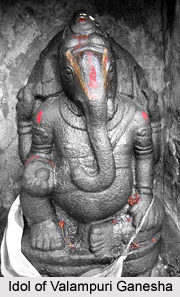 The Legends of Lord Ganesha and Lord Vishnu are discussed in the ancient Mahapuranas and Upapuranas, like Linga Purana, Shiva Purana, Ganesha Purana, Padma Purana, Mudgala Purana, Brahmavaivarta Purana and Varaha Purana. Lord Ganesha is extensively worshipped by Hindus, Buddhists and Jains. He is the God of wisdom and is also considered as the deity of new ventures and good fortune. Lord Ganesha, also known as Ekadanta, Vinayaka and Gajanana, is the son of Lord Shiva and Goddess Parvati. Lord Kartikeya (Skanda) is the brother of Ganesha.
The Legends of Lord Ganesha and Lord Vishnu are discussed in the ancient Mahapuranas and Upapuranas, like Linga Purana, Shiva Purana, Ganesha Purana, Padma Purana, Mudgala Purana, Brahmavaivarta Purana and Varaha Purana. Lord Ganesha is extensively worshipped by Hindus, Buddhists and Jains. He is the God of wisdom and is also considered as the deity of new ventures and good fortune. Lord Ganesha, also known as Ekadanta, Vinayaka and Gajanana, is the son of Lord Shiva and Goddess Parvati. Lord Kartikeya (Skanda) is the brother of Ganesha.
The ancient Hindu religious scriptures state that once Lord Vishnu realized that his Valampuri Shankha (Valamburi Shankha) had vanished. This made the Vishnu very irritated and infuriated. Later the Lord heard the distinctive resonance of a conch shell that came from far away. Lord Vishnu instantaneously identified the sound and recognized it was coming from his own Valampuri Shankha. He listened closely and realized that the divine sound was coming from Mount Kailash.
Lord Vishnu meditated and prayed to Lord Shiva, who appeared to him. Shiva announced that his son had found the sacred conch shell and Vishnu needed to pray to Valampuri Ganesha (an incarnation of the deity with his trunk turned towards the right side) in order to get his instrument back. Hence, Lord Vishnu organized a religious ritual to worship Lord Ganesha. Later the noble child returned the Shankha to its rightful owner. Vishnu became pleased to receive his instrument and blessed the child.
This article is a stub. You may enrich it by adding more information to it. You can send your write-up at content@indianetzone.com




















